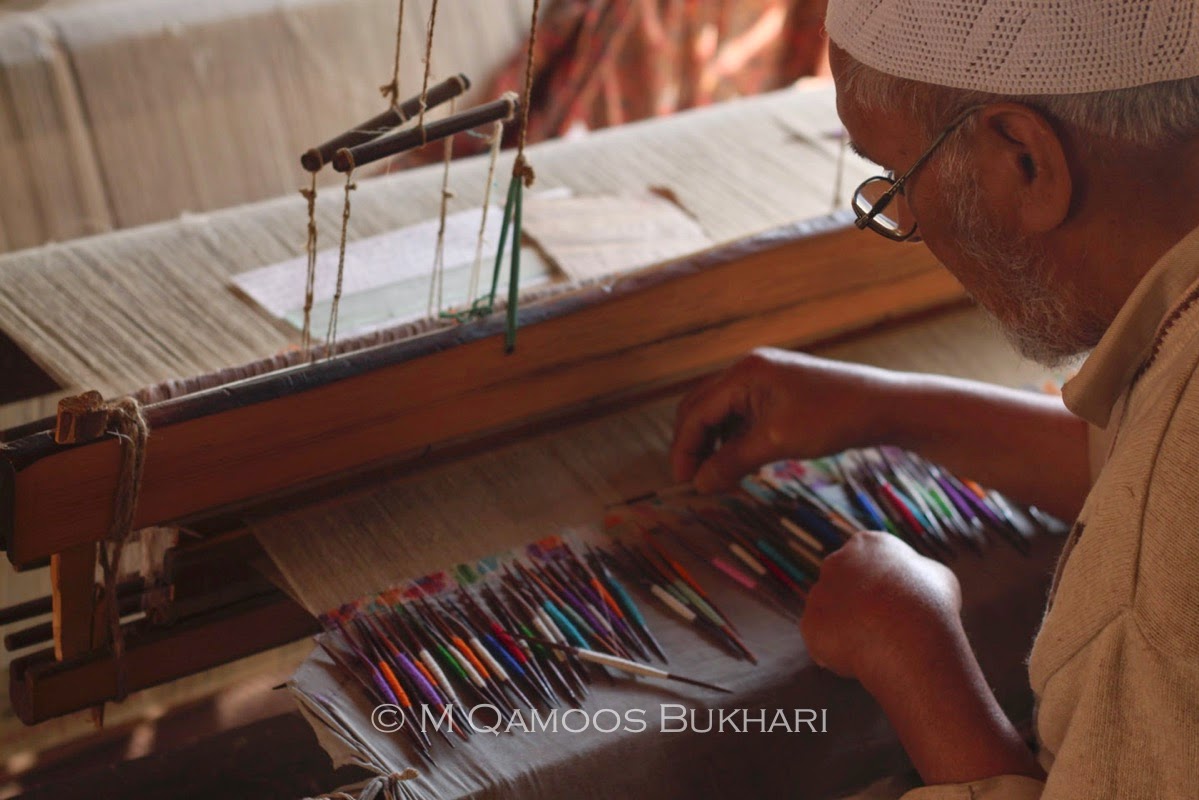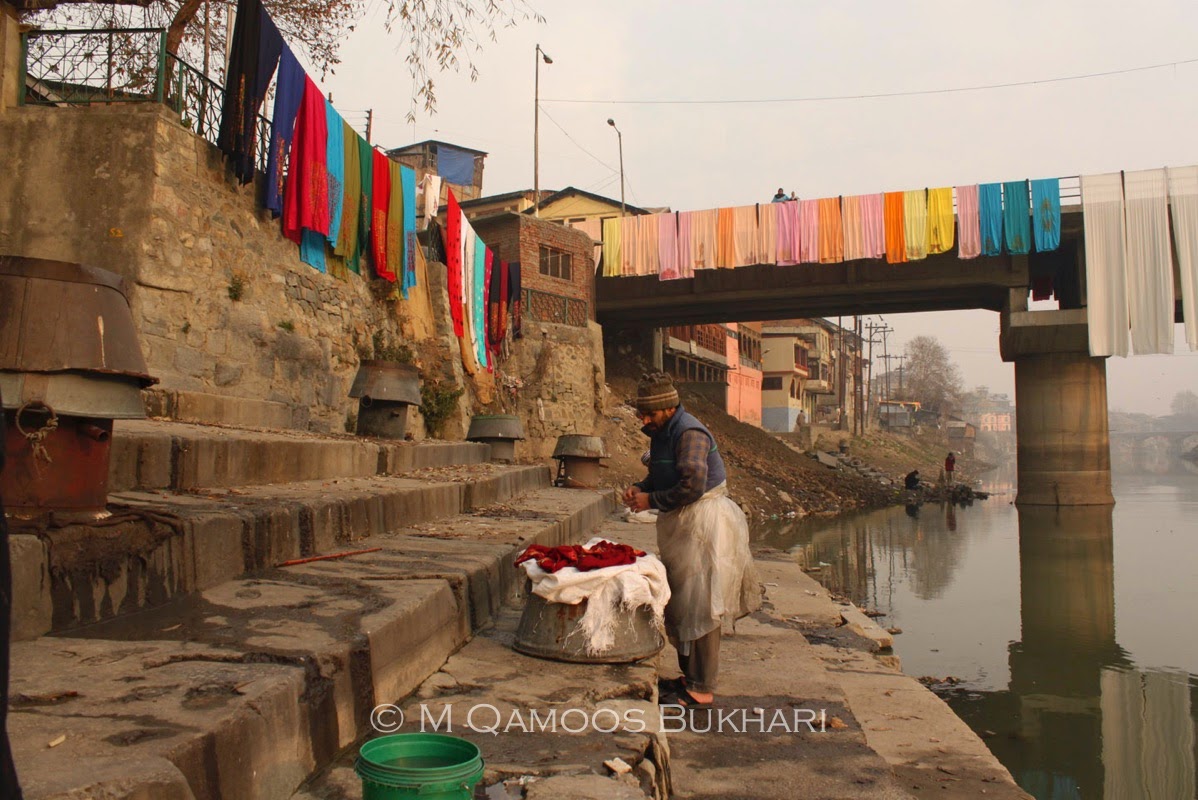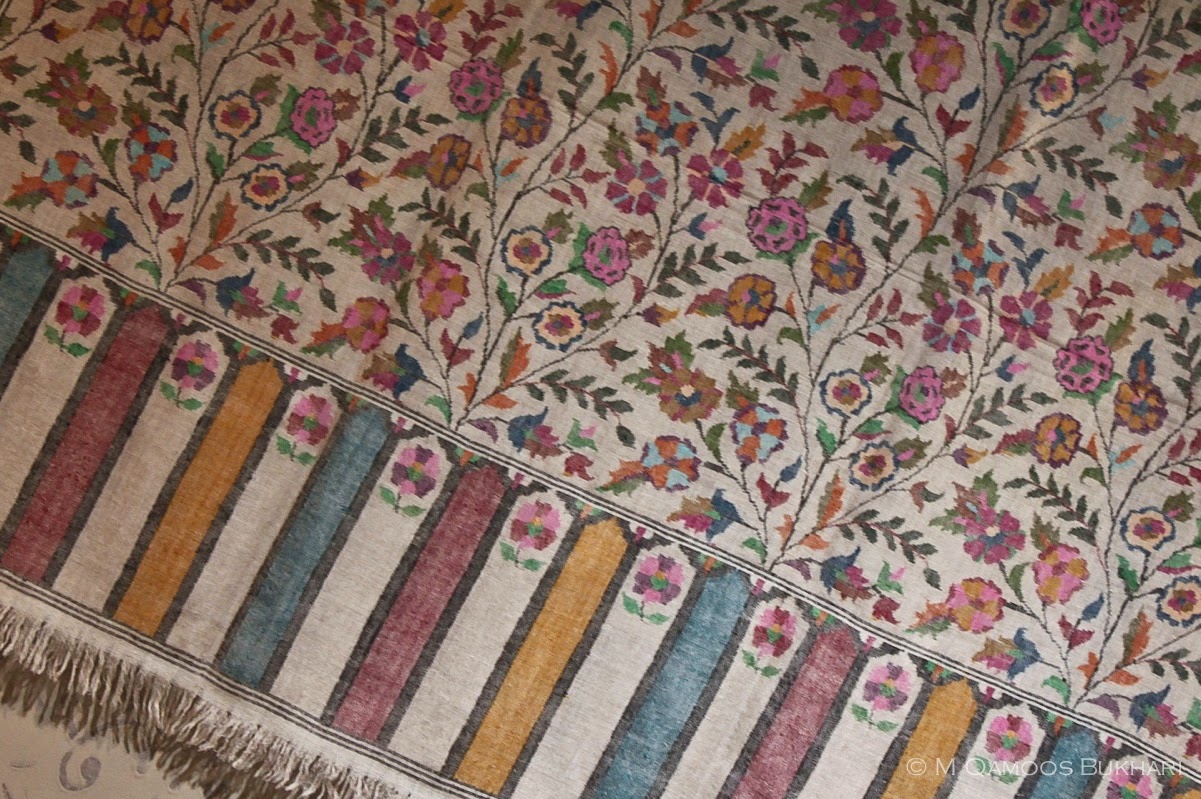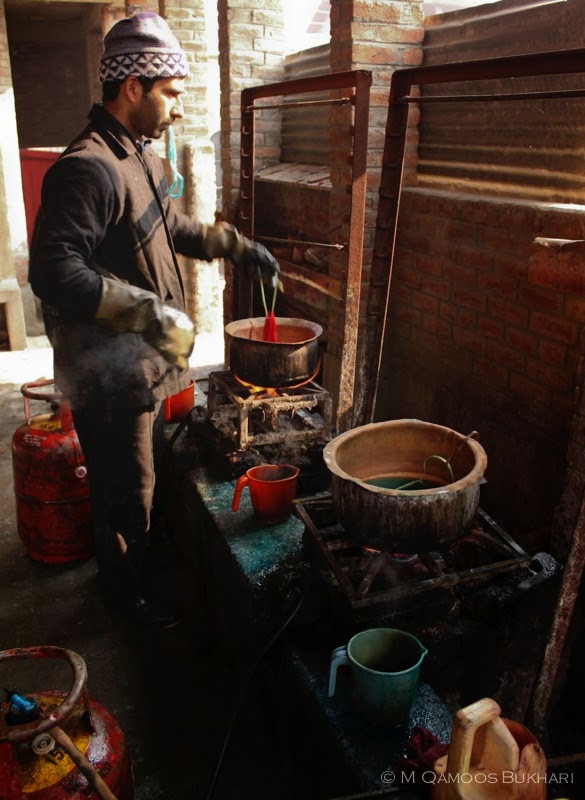When I was in India recently, I was fortunate to see for the first time a collection of exquisite Kani shawls, handwoven in Srinigar, Kashmir.
I also met an ecceptional young Kashmiri student at the Kashmir Loom studio in Delhi.
Qamoos Bukhari is his name. It turns out that he is a very talented and inspiring young photographer—and that he has a story to tell, of Kashmir and handcrafted cashmere shawls, and beauty and devotion. And there is more to this story.
This week on THE STYLE SALONISTE, come with Qamoos and me to Srinigar, Kashmir, to see where the most beautiful cashmere handwoven shawls are crafted. And learn the tragic news. The images crafted by Qamoos, never published or shown, portray the beauty and centuries-old crafts of that region.
Qamoos has a fascinating story, which he told me recently. It will be of great interest to my designer readers, and everyone who loves beauty.
I met Qamoos Bukhari, 20, because he is working on the autobiography of Jenny Housego, the wonderful co-owner of Kashmir Loom, a twenty-year-old company that sells the most exquisite cashmere shawls. I’ve written about Jenny and Kashmir Loom in my reports on India. She offers the finest cashmere and pashmina shawls, authentic and hand-woven and many of them hand-embroidered in traditional patterns and with the finest silk threads and exceptional craftsmanship.
Qamoos was visiting Jenny the day I stopped in to select pashmina shawls. He is studying in Delhi.
Come and find out more—and learn about rare KANI shawls, the finest, and a story of Srinigar.
It is a long and compelling story. I propose that you turn on the kettle, and make a cup of Chai, traditional spicy Indian tea. Or, like me, put some loose-leaf Assam tea in the teapot, pour boiling water over it, wait for ten minutes…and sip the most delicious tea, and read this exclusive story.
The traditional patterns are Persian motifs that crisscross the shawl in elaborate and symbolic designs. The colors are soft and harmonious, usually vegetable dyes.
The cashmere and pashmina yarns are from the soft underbelly of the cashmere goat, and yarns are hand-spun, usually by women. (These are not shatoosh shawls, which are illegal.)
Kani shawls are made on old wooden looms, always by men. They devote their lives to crafting these luxurious and butter-soft works of art, some of which may take months or years to complete. In India they may sell for $2,000 to $3,000 and more. They are as soft as butter, with a creamy warmth and sensuality that is specific to these woven beauties.
Traditionally they have striped borders. I particularly admire shawls with a black background, and love those in natural undyed cashmere/pashmina yarn that is rare and neutral and very beautiful. I don’t own one.
I asked Qamoos Bukhari to tell me about this rare artistry which is now in danger of dying out.
I appreciate that he has given permission for me to publish these images exclusively for my readers. His family arrived in Kashmir several centuries ago from Persia, along with Kani weavers, musicians, artists, embroiders, and the many craftspeople that surrounded Mughul and religious leaders.
Qamoos Bukhari said:
“Kani weaving is a male dominated profession. Women in Kashmir create the very fine embroidery. With my photography, I have here focused specifically on 'The art of weaving Kani'. I have spent nearly three years now on just working on Kani.”
In our conversation, Qamoos Bukhara told me:
“I clearly remember a decade ago when I was ten years old we were going to Gulmarg in Kashmir. It is known as one of the worlds best ski resort and on our way, waiting desperately to reach there and go skiing I was reading every sign board that came across, one sign board read as KANIHAMA : Gulmarg 32 Km.”
“Not able to pronounce properly I asked my father what is this KANIHAMA and what has it to do with Gulmarg. He answered this is a place through which we are driving now. This is the place where Kani shawls are actually made, and that's the reason; for centuries now this place is named after Kani shawls. Then I asked what does Kani mean and he answered Kani in Kashmiri means a stick, which the weavers use as a needle to make a Kani shawl. When we came back home he showed me a Kani shawl. It was so beautiful. Thus began my project.”
Qamoos continued:
“I was stunned and asked him why don't I see everybody with this beautiful shawl? it's Winter in Kashmir and everybody drapes a shawl. He kept telling me but I kept asking him about this subject and he kept answering my questions. I got fascinated with the never-ending mystery, which was in my mind about this kind of shawl.”
“Finally three years ago I formally started researching on the art of weaving Kani through the medium of photography and got the answer for my question. Everybody doesn't have a Kani shawl because it takes very long and is very intricate to craft and is therefore very expensive.”
“While working on my project one weaver told me the moment his father heard that Kani is being replicated by machine work and is being sold with the label Kani from Kashmir, he stood up from his loom bench and stopped working, and pledged to his son that now onwards he will stop working on Kani. He was 125 years old and still used to work but when he heard this in the year 2001 he stopped working and couple of days after this he left this World. His youngest son who is 87 still weaves. He told me, 'I just make a single shawl a year, the same that my father used to do, and we both have mastered just a single design.'”
“I asked him, 'Can't you make anything else?' and he laughed and said I can weave anything even the scene before my eyes. I am 87 years old and have made seventy-seven shawls of a single pattern in whole my life.”
Qamoos shot his images over three years — and then the floods came last September. He reported to me this Winter:
“I am straight away writing to you after coming from ten hour continuous work. Today I met most of the people associated with the craft that I know from past three years now. It has been a very sad and disheartening shoot today. Recent floods have take away everything. The picture of a Temple, and River, Shawls I sent you is a memory now, floods have washed away the beauty of that scene, The temple is in a pathetic condition, damaged; hundreds of years old wooden windows and things have been taken away by waters, it is destroyed. The banks are full of mud, silt and garbage.”
“I went to some new looms also but I could not make out anything from the scene there, except new unknown faces on the loom. Tomorrow I am driving to some villages to meet some old weavers there, perhaps the oldest Kani weaver also, who is 93 and still sits on a loom; I have sent you a picture of him also. I am going to meet him again and hope I’ll get something new tomorrow.”
“It is haunting there. I was shocked and got stuck with my memory for a moment as I had a reverie of transition in my sensation. People today have been telling me you are lucky, you had captured what you wanted on time. I am pleased.”
Qamoos reported to me recently:
“Today I spent my day in a Dyeing Workshop, and thankfully I got some shots; check the enclosed attachments.”
“Tomorrow is Friday; Artisans’ Holiday. On Saturday I have been asked by some weavers to come to their loom. I have been to them many times before, but not since one year now. So I will be going there on Saturday; perhaps the only loom I have not visited from last three days now. I have been to each and every Kani Loom I know from years now.”
“Everybody is affected by floods in one way or the other, but mostly washermen face many difficulties while washing on the polluted banks now. Well...for their living they are working very hard. Some workers have lost their homes but still in a need, managing to work to earn their bread.”
Many ‘authentic Kani shawls’ are offered online. I can see by the shiny surface and patterns that they are machine made, most of them. Now after the floods damaged looms, authentic Kani will become even more rare.
When you have seen the handcrafted surface of a real Kani (not entirely smooth and with the texture of handwork) and felt the rare and thrilling whipped cream softness of a Kani shawl, and seen the subtle and sometimes floral-bright colors, you can instantly discern a factory-made simulation.
How to find a Kani: It is not advised to travel to Srinigar at the moment, but contact Kashmir Loom in New Delhi, which occasionally (seldom) has a small collection.
Contact Jenny Housego at www.kashmirloom.com.
I have grown watching cameras and things around me, talks, teachings on arts and aesthetics through which my father made me familiar with the surroundings.
In a way I am attached to camera in a sense, my each and every moment is captured by it.
Ideologically I think my life is witnessed by a camera. There is a big glass almirah in our house in Srinagar which has all the old and antique cameras my father possesses. It was inevitable that I would pick up a camera and record historic arts in Srinigar. I am now a student in New Delhi, but often return home to visit my loving family.
CREDIT:
All exclusive images here were photographed by M. Qamoos Bukhari in Srinigar, Kashmir.
Last September 2014, the Srinigar region of Kashmir was hit by severe floods that damaged many residences, destroyed bridges and historic buildings, and wrecked many of the ancient wooden looms that craftsmen use to make pashmina, wool, silk, and Kani shawls.
I have donated to UNICEF and Save the Children. Specifically.
I also met an ecceptional young Kashmiri student at the Kashmir Loom studio in Delhi.
Qamoos Bukhari is his name. It turns out that he is a very talented and inspiring young photographer—and that he has a story to tell, of Kashmir and handcrafted cashmere shawls, and beauty and devotion. And there is more to this story.
This week on THE STYLE SALONISTE, come with Qamoos and me to Srinigar, Kashmir, to see where the most beautiful cashmere handwoven shawls are crafted. And learn the tragic news. The images crafted by Qamoos, never published or shown, portray the beauty and centuries-old crafts of that region.
Qamoos has a fascinating story, which he told me recently. It will be of great interest to my designer readers, and everyone who loves beauty.
I met Qamoos Bukhari, 20, because he is working on the autobiography of Jenny Housego, the wonderful co-owner of Kashmir Loom, a twenty-year-old company that sells the most exquisite cashmere shawls. I’ve written about Jenny and Kashmir Loom in my reports on India. She offers the finest cashmere and pashmina shawls, authentic and hand-woven and many of them hand-embroidered in traditional patterns and with the finest silk threads and exceptional craftsmanship.
Qamoos was visiting Jenny the day I stopped in to select pashmina shawls. He is studying in Delhi.
Come and find out more—and learn about rare KANI shawls, the finest, and a story of Srinigar.
It is a long and compelling story. I propose that you turn on the kettle, and make a cup of Chai, traditional spicy Indian tea. Or, like me, put some loose-leaf Assam tea in the teapot, pour boiling water over it, wait for ten minutes…and sip the most delicious tea, and read this exclusive story.
The Fine Craft of Kani Shawls
Kani shawls are rare, precious and seldom seen outside India.The traditional patterns are Persian motifs that crisscross the shawl in elaborate and symbolic designs. The colors are soft and harmonious, usually vegetable dyes.
The cashmere and pashmina yarns are from the soft underbelly of the cashmere goat, and yarns are hand-spun, usually by women. (These are not shatoosh shawls, which are illegal.)
Kani shawls are made on old wooden looms, always by men. They devote their lives to crafting these luxurious and butter-soft works of art, some of which may take months or years to complete. In India they may sell for $2,000 to $3,000 and more. They are as soft as butter, with a creamy warmth and sensuality that is specific to these woven beauties.
Traditionally they have striped borders. I particularly admire shawls with a black background, and love those in natural undyed cashmere/pashmina yarn that is rare and neutral and very beautiful. I don’t own one.
I asked Qamoos Bukhari to tell me about this rare artistry which is now in danger of dying out.
Qamoos shot all of these images as a three-year project.
 |
| Qamoos Bukhari |
I appreciate that he has given permission for me to publish these images exclusively for my readers. His family arrived in Kashmir several centuries ago from Persia, along with Kani weavers, musicians, artists, embroiders, and the many craftspeople that surrounded Mughul and religious leaders.
Qamoos Bukhari said:
“Kani weaving is a male dominated profession. Women in Kashmir create the very fine embroidery. With my photography, I have here focused specifically on 'The art of weaving Kani'. I have spent nearly three years now on just working on Kani.”
“Once a weaver told me 'My shawl is my companion, I work on it most of the time, It will take me two years to make this, This shawl absorbs my emotions, feelings...everything of the two years of my life. The colors of the shawl are witness of my life.'”
In our conversation, Qamoos Bukhara told me:
“I clearly remember a decade ago when I was ten years old we were going to Gulmarg in Kashmir. It is known as one of the worlds best ski resort and on our way, waiting desperately to reach there and go skiing I was reading every sign board that came across, one sign board read as KANIHAMA : Gulmarg 32 Km.”
“Not able to pronounce properly I asked my father what is this KANIHAMA and what has it to do with Gulmarg. He answered this is a place through which we are driving now. This is the place where Kani shawls are actually made, and that's the reason; for centuries now this place is named after Kani shawls. Then I asked what does Kani mean and he answered Kani in Kashmiri means a stick, which the weavers use as a needle to make a Kani shawl. When we came back home he showed me a Kani shawl. It was so beautiful. Thus began my project.”
 |
| The photo of the old man on loom: He is 93 and is the oldest living weaver of Kani in Kashmir. |
Qamoos continued:
“I was stunned and asked him why don't I see everybody with this beautiful shawl? it's Winter in Kashmir and everybody drapes a shawl. He kept telling me but I kept asking him about this subject and he kept answering my questions. I got fascinated with the never-ending mystery, which was in my mind about this kind of shawl.”
“Finally three years ago I formally started researching on the art of weaving Kani through the medium of photography and got the answer for my question. Everybody doesn't have a Kani shawl because it takes very long and is very intricate to craft and is therefore very expensive.”
“While working on my project one weaver told me the moment his father heard that Kani is being replicated by machine work and is being sold with the label Kani from Kashmir, he stood up from his loom bench and stopped working, and pledged to his son that now onwards he will stop working on Kani. He was 125 years old and still used to work but when he heard this in the year 2001 he stopped working and couple of days after this he left this World. His youngest son who is 87 still weaves. He told me, 'I just make a single shawl a year, the same that my father used to do, and we both have mastered just a single design.'”
“I asked him, 'Can't you make anything else?' and he laughed and said I can weave anything even the scene before my eyes. I am 87 years old and have made seventy-seven shawls of a single pattern in whole my life.”
Qamoos shot his images over three years — and then the floods came last September. He reported to me this Winter:
“I am straight away writing to you after coming from ten hour continuous work. Today I met most of the people associated with the craft that I know from past three years now. It has been a very sad and disheartening shoot today. Recent floods have take away everything. The picture of a Temple, and River, Shawls I sent you is a memory now, floods have washed away the beauty of that scene, The temple is in a pathetic condition, damaged; hundreds of years old wooden windows and things have been taken away by waters, it is destroyed. The banks are full of mud, silt and garbage.”
“I went to some new looms also but I could not make out anything from the scene there, except new unknown faces on the loom. Tomorrow I am driving to some villages to meet some old weavers there, perhaps the oldest Kani weaver also, who is 93 and still sits on a loom; I have sent you a picture of him also. I am going to meet him again and hope I’ll get something new tomorrow.”
“It is haunting there. I was shocked and got stuck with my memory for a moment as I had a reverie of transition in my sensation. People today have been telling me you are lucky, you had captured what you wanted on time. I am pleased.”
Qamoos reported to me recently:
“Today I spent my day in a Dyeing Workshop, and thankfully I got some shots; check the enclosed attachments.”
“Tomorrow is Friday; Artisans’ Holiday. On Saturday I have been asked by some weavers to come to their loom. I have been to them many times before, but not since one year now. So I will be going there on Saturday; perhaps the only loom I have not visited from last three days now. I have been to each and every Kani Loom I know from years now.”
“Everybody is affected by floods in one way or the other, but mostly washermen face many difficulties while washing on the polluted banks now. Well...for their living they are working very hard. Some workers have lost their homes but still in a need, managing to work to earn their bread.”
A Note from Diane
Authentic Kani shawls are so rare; I’ve only ever seen a few in all the many years I’ve been traveling to India. They are not shatoosh shawls, which are illegal.Many ‘authentic Kani shawls’ are offered online. I can see by the shiny surface and patterns that they are machine made, most of them. Now after the floods damaged looms, authentic Kani will become even more rare.
When you have seen the handcrafted surface of a real Kani (not entirely smooth and with the texture of handwork) and felt the rare and thrilling whipped cream softness of a Kani shawl, and seen the subtle and sometimes floral-bright colors, you can instantly discern a factory-made simulation.
How to find a Kani: It is not advised to travel to Srinigar at the moment, but contact Kashmir Loom in New Delhi, which occasionally (seldom) has a small collection.
Contact Jenny Housego at www.kashmirloom.com.
About Qamoos Bukhari: His Biography
I am 20 years old. I was born in Srinagar but have spent most of time in various different parts of India, mainly because of my father’s profession as a cinematographer.I have grown watching cameras and things around me, talks, teachings on arts and aesthetics through which my father made me familiar with the surroundings.
In a way I am attached to camera in a sense, my each and every moment is captured by it.
Ideologically I think my life is witnessed by a camera. There is a big glass almirah in our house in Srinagar which has all the old and antique cameras my father possesses. It was inevitable that I would pick up a camera and record historic arts in Srinigar. I am now a student in New Delhi, but often return home to visit my loving family.
CREDIT:
All exclusive images here were photographed by M. Qamoos Bukhari in Srinigar, Kashmir.
Last September 2014, the Srinigar region of Kashmir was hit by severe floods that damaged many residences, destroyed bridges and historic buildings, and wrecked many of the ancient wooden looms that craftsmen use to make pashmina, wool, silk, and Kani shawls.
I have donated to UNICEF and Save the Children. Specifically.















8 comments:
What an incredible tale of both beauty, and yes, tragedy Diane. Your travels take us to a world I know I would not know if it were not for you. Thank you.
xoxo
Karena
Featuring The HighBoy
Thank you so much Diane for such a wonderfully informative and beautiful post. You are so very fortunate that you have witnessed such beauty and hence, can feel for the devastation they have gone through with the floods.
what a lovely story so sad but true + I have never seen a Kani + now I know about them + thanks to you.xxpeggybraswelldesign.com
Amazing story. Thank you for sharing.
Dear Friends
I'm so happy to hear your thoughts.
I received a wonderful message today:
Jean Wethmar
February 10 at 2:13pm
Your insight amazes me Diane.. thanks for sharing this very beautiful story with us.. cant wait to travel there in November.. thanks again
Those fabrics are phenomenal for lack of a better word! I have a friend who does work there for several months a year and says that it is a place that is a must to visit but because it is so beautiful people are always fighting to own it...Thank you for sharing.
great post!
google
NICE BLOG!!!
Post a Comment